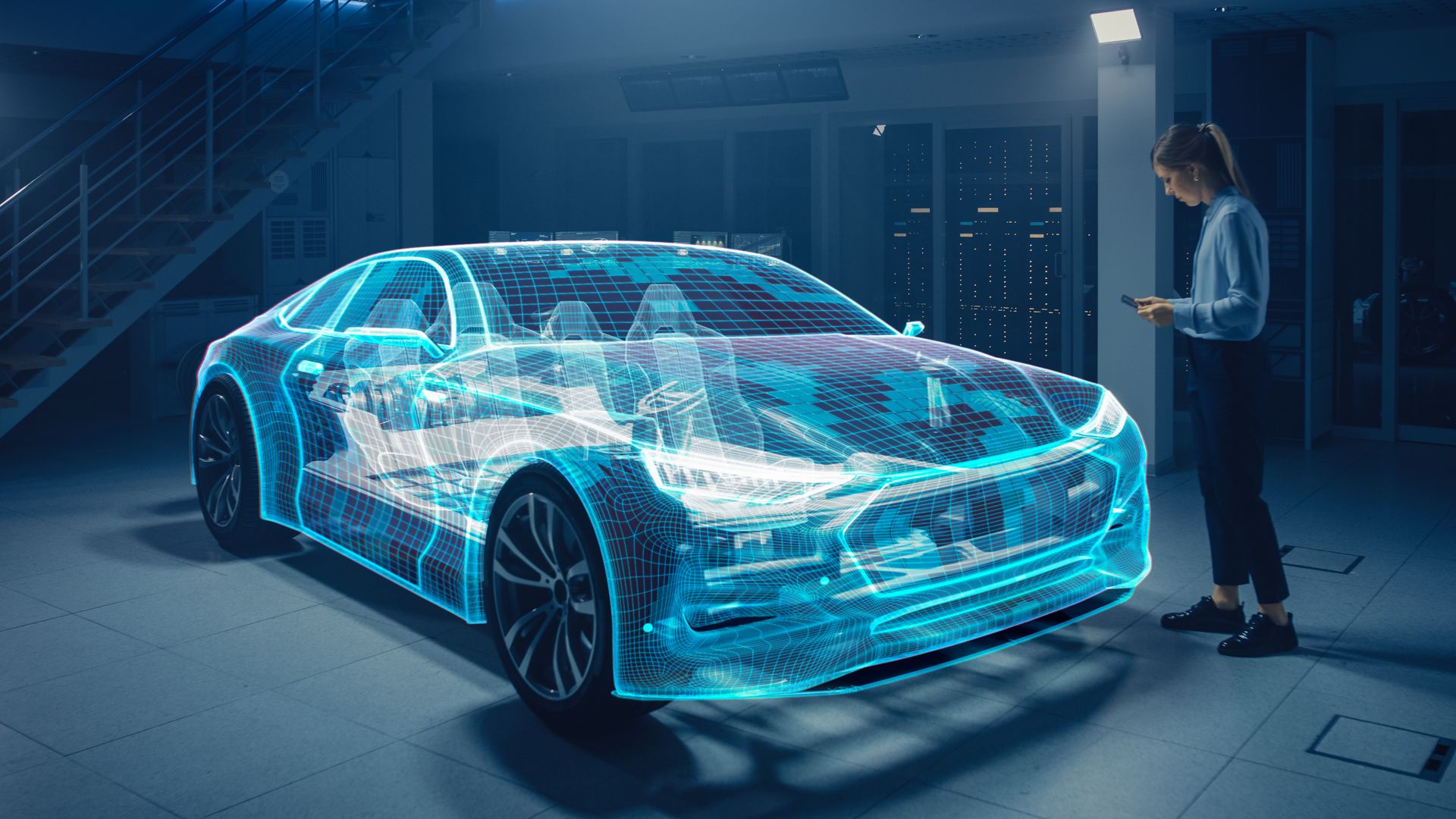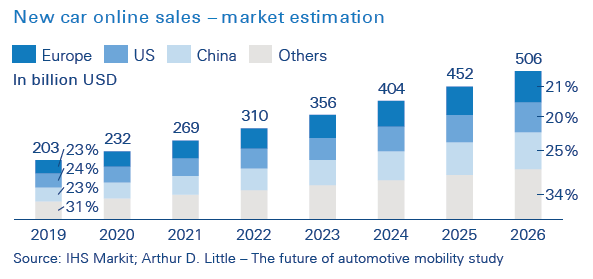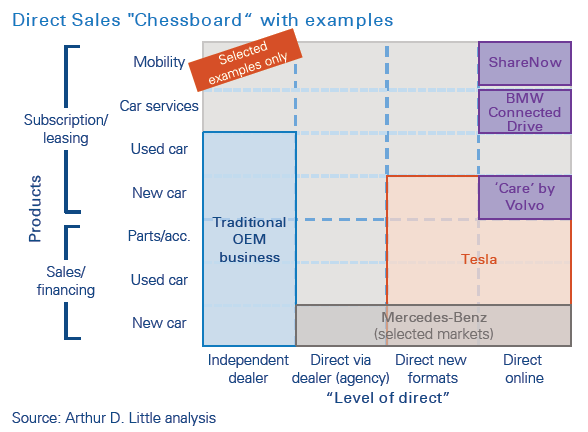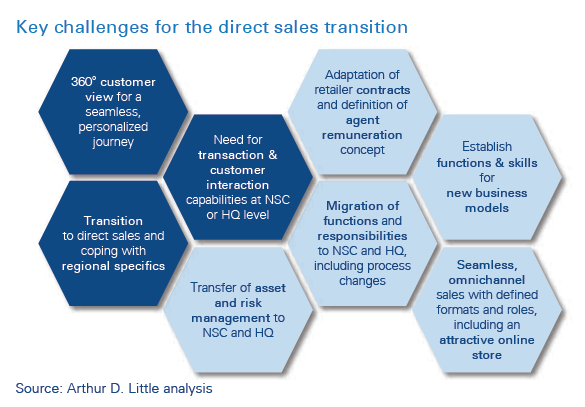
The physical retail store for goods and services is losing ground to new sales models and channels. Online retail, often in a direct sales set-up, continues to gain market share in almost every product category. In the automotive industry, players such as Tesla and electric vehicle (EV) start-ups, without existing widespread sales networks, sell directly through new channels, including online, urban boutiques and pop-up stores. Besides more variety in sales formats, this allows for limiting of retail costs and payout of margins to dealer networks. Established carmakers must find ways to match these new business models and customer requirements for more convenient, personalized and digital relations, in sales and after-sales.
Current OEM direct sales activities
Many car original equipment manufacturers (OEMs) have already started to move towards a direct sales model – however, the overall maturity of initiatives differs. Some players have implemented direct sales for certain products, such as spare parts and used cars, while others have piloted direct sales in specific geographic markets.
The most prominent challenges for OEMs when implementing direct car sales are existing contracts with dealer networks and legal constraints, such as multiple US federal states prohibiting sales without local dealership networks. At the same time, mitigating dealers’ concerns about competition from direct OEM sales has proven to be a major issue. In many cases this is tying up significant resources and resulting in negative press coverage, delaying the move towards direct sales.
Players such as Geely, Tesla and Hyundai, however, are consistently pursuing strategies towards direct sales models. Without the full indirect sales legacy, they apply new, more radical approaches:
- Massively scaling back or avoiding setting up brick-andmortar retail networks in favor of new formats (e.g., flagship and pop-up stores) or shifting sales to online channels.
- Offering alternative ownership models such as full-service rental options including, e.g., maintenance, insurance and tax.
- Lenient return policies to enable clients to test cars without the need for test drives through local dealerships.
Why go direct?
Under pressure from multiple sides, carmakers are rethinking the traditional three-level sales model (headquarters, wholesale, retail). Newer players such as Tesla have the advantage of entering the market in a “greenfield” approach with no legacy structures. This allows for a lean set-up, online-centric processes and minimalistic numbers of retail points. Established OEMs are struggling with substantial retail costs due to dense sales networks – which used to be a competitive advantage.

Since online customers are already used to high levels of convenience and online shopping experiences from other industries, they expect no less when buying cars. Currently, the online auto business is primarily exploited by new entrants such as online brokers. Multi-brand online platforms that bridge the gap between customer and dealer lead to price transparency and foster dangerous intra-brand competition. While dealerships from different sales territories underbid each other in the online segment, brokers such as Carwow achieve significant growth and commissions at the cost of the dealers’ and manufacturers’ profit margins.
Over the past few years, multiple studies and publications have dealt with customers’ readiness to purchase cars, especially new vehicles, directly online. Estimations range from 30 to 70 percent, with some going even higher. In Arthur D. Little’s Future of automotive mobility study, which surveyed over 8,000 driver’s-license holders from 13 countries, only 8 percent of participants indicated that they would “probably use online purchase and payment when buying a new or used car”. This estimation specifically excludes referrals to physical dealerships via online platforms. “Online sales” describes completion of the sale, and thus the checkout process, including the customer’s choice of payment method over the internet.

Because this will gain future importance, we expect an increase in car sales’ online penetration rate of at least 1 percentage point per year, which will lead to an online revenue share of 15 percent in 2026. Based on this insight, the market potential for worldwide new-car online sales can be estimated to reach 506 billion USD in 2026. To exploit this potential and reach their ambitious online sales targets, OEMs will face numerous challenges. An efficient direct sales model is an important puzzle piece when striving for efficient and scalable online sales.
The traditional indirect sales model, with dealers as independent entrepreneurs, makes a “360-degree customer view” and personalized online marketing more difficult for OEMs because customer data is scattered across dealers and sales levels. A direct customer interface is required to generate tailor-made offerings and enable cross- and upselling between product categories such as new cars, after-sales and mobility services. As the industry shifts from hardware sales to mobility solutions, a personalized, end-to-end customer experience is becoming a competitive advantage. Hence, established carmakers need to find the right balance between direct and indirect sales to avoid outpacing their dealer networks.
Direct sales models – what is the playing field?
Since cars have become more connected and features such as data-based and localized services have been added, manufacturers have been technically engaging in direct sales models. Once a customer subscribes to an online service such as real-time traffic information, he or she has entered into a direct contract with the OEM.
Online services are only one example from a broad product portfolio offered through multiple sales models. Therefore, it is necessary to further define the playing field for direct sales, which can be depicted as a chessboard with multiple squares on which to position. One dimension of the playing field is the “level of direct”, in which four sales models can be identified within the industry. One of these is the traditional three-level sales approach with independent dealers. The first step towards direct sales is often an agency model. Without necessarily changing the retail experience for the customer, the dealer acts as an agent for the manufacturer – selling cars that are owned by the OEM, on behalf of the OEM, and obtaining a sales commission instead of a profit margin. Besides using existing retail structures, the agent model can easily be combined with new sales formats, such as pop-up stores, urban boutiques and roadshows. An even more radical form of direct sales is online retail without brick-and-mortar showrooms (see figure below).

The second dimension of the playing field is the offering and business-model portfolio. Considering the product range of OEMs and new ownership models, multiple business models enter the option space. Having started with subscription models for mobility and in-car services, OEMs are now extending these to the car itself. The example “Care by Volvo” shows that the transition between leasing and subscription depends on the characteristics of the business model. Some OEMs offer a limited range of pre-selected vehicles that can be switched monthly depending on the customer’s preference. Others sell subscription models as a modern form of full-service leasing, tying their customers to the same car for at least two years with a monthly rate that includes all costs except fuel.
The direct sales “chessboard” structures the options of shifting to direct sales according to products and the “level of direct”. As a first step, the OEM needs to decide how to move across the chessboard and which direction to take regarding products, customers, business models, channels, localization and timing.
How to go direct? Key challenges and solutions for established carmakers
Throughout the transition process towards direct sales, OEMs face several challenges – some more pronounced than others, depending on their legacy organizations and histories. Based on our experience with OEMs, we have identified eight key challenges when shifting to a direct sales model in the automotive industry (see figure overleaf).
Three exemplary challenges will be detailed here, including our perspective of winning strategies.

Key challenge #1: A 360-degree customer view
In an online-focused direct sales model, efficient customer relationship management (CRM) and customer data storage systems are key components to guide customers through the sales process. They enable identification and personalized interaction across all touchpoints. Although the functional scope of CRM largely remains the same, covering campaign, lead and care management, it becomes a key element in integrating touchpoints in an omnichannel world.
In a direct sales model, many retail functionalities need to be addressed by a central CRM that can provide customer insight and analytics. The omnichannel experience of configuring a car on your tablet at home and finalizing it in a store is enabled jointly by CRM and available customer data. Centralizing customer data has always been a hurdle for OEMs due to dealer agreements. Several OEMs are currently renegotiating dealer contracts and incorporating facets to allow central customer data management.
Strategy impulse: To use immersive CRM and customerdata solutions to their full potential, the customer needs to be “known” to the OEM at each touchpoint. In the online world this is accomplished if the customer is signed into an account. In direct sales it is crucial to increase the attractiveness of account creation from a customer perspective. Tangible customer benefits should be accompanied by strategic, mandatory “log-in points”. OEMS must be able to identify customers at the current journey step to guide them through the process, and thus directly improve KPIs such as conversion rates.
The first strategic decision OEMs need to make involves defining log-in points. From our experience and best practices in other industries, it is a “must” in online sales to link the purchase to a customer ID. For other journey steps, we recommend evaluating each step in each channel to decide whether it requires a log-in. Online test-drive booking, for example, has considerable value for the customer, which justifies creating an account. Additional log-in points can be a newsletter subscription or the request of an offer. OEMs may not want to bother clients with account creation at these stages. However, new players and tech giants moving into the market will not hesitate when it comes to “forced” account creation to obtain a 360-degree view of the customer.
Key challenge #2: Transaction and customer interaction capabilities at NSC or HQ level
In direct, online-based sales, a lot of customer interaction moves to a contact center (CC) at national service center (NCS) or HQ level, even though physical touchpoints remain (such as agents and flagship stores). The CC gains importance when supporting and advancing the customer along the journey. Although traditional support functionalities such as complaint management remain, the CC becomes more sales-oriented. New dialogue functionalities range from product consultation and test-drive booking to offer generation and negotiation, and all the way to finalizing the purchase.
Increased product complexity with new digital and mobility services, as well as a broader range of dialogue incidents, require a well-balanced CC set-up to deliver professional consultation for the entire portfolio. This challenge is often intensified by fragmented CC structures. However, the transition to a direct sales model also provides the opportunity to streamline legacy structures in the CC set-up.
Strategy impulse: Strong central governance helps achieve consistency across CC entities in different regions by defining strategic dialogue guidelines, roles and functionalities. Future dialogue cases need to be identified per product to establish CC functions and new interaction channels such as live chat, instant messaging and mobile apps. A suitable channel mix and a seamless channel transition also need to be ensured. However, omnichannel communication is not a must-have: although many offer well-balanced channel mixes, there are also good practices that focus on one interaction channel.
Future-proofing the CC set-up brings the opportunity to use new technologies such as chatbots and artificial intelligence. These can help significantly when solving level 1 questions and optimizing internal operations, e.g., via smart routing solutions or on-the-job training with AI-based tools. However, they are still in the early stages and often not perceived well by clients.
CC functions are typically split between HQ and NSC levels. It is beneficial to include regional stakeholders to consider market characteristics and allocate responsibilities accordingly. Smart market clustering creates significant synergies in the CC set-up.
Key challenge #3: Transition to direct sales and coping with regional specifics
A direct car-sales model is nothing to decide and implement overnight. In addition to the mentioned challenges, the transition from indirect to direct is a tricky endeavor.
- Legal constraints bind OEMs to dealerships for all products for the duration of the contract, and those contracts are usually market specific.
- Legal restrictions prohibit direct sales in some regions and markets for certain products.
- Changing processes and structures to mirror the shift of retail and customer-care functions is a complex transition and change management task.
Strategy impulse: OEMs’ steps towards direct sales were historically more successful when small, incremental moves were made. Direct sales for new products (e.g., charging services or subscription models) that are not under dealer contracts could be used as a starting point. Expiring dealer contracts in certain markets and renegotiations open additional opportunities. Successful OEMs offer their dealer networks compensation for decreasing sales margins, e.g., new service businesses or taking advantage of the ongoing consolidation process in car retail.
Moving ahead in regional clusters and piloting direct sales of certain products in selected markets has been a winning strategy. This approach reduces rollout complexity and the risk of failure. It allows use of opportunities in individual markets, such as expiring contracts, new legislations or product launches. Therefore, we recommend a decentralized realization approach and regional clustering by homogenous legal environments, customer requirements and product specifications.
Conclusion
Transitioning to direct sales is a major trend in car sales, driven by customers’ increasing willingness to buy online; new ownership, usage and business models; and competitors entering the market without legacy structures. Although OEMs are still widely bound to indirect sales by legislation and current contracts with business partners, they must adapt their structures and develop holistic strategies to cover people, processes and technology.
Selected products and pilots in certain geographies pave the way to broader application of direct sales and enable OEMs to collect the first hands-on experiences. Additionally, necessary enablers need to be put in place, not least to provide seamless online-offline integration. Pushing the customer to create an online account and leave a data profile directly with the OEM is only one exemplary prerequisite for a personalized and convenient customer experience across sales channels. (Read more in our viewpoint, The dark side of the moon: Online-offline integration in automotive retail).
Ultimately, new skills and far-reaching adaptations of its system landscape are inevitable if the OEM is to enable and support consistent processes within a direct sales model. The transition to direct sales and moving successfully across the direct sales “chessboard” requires a clear set of strategic decisions and implementation steps that are flexible and agile enough to cope with unforeseen setbacks and dynamics.





